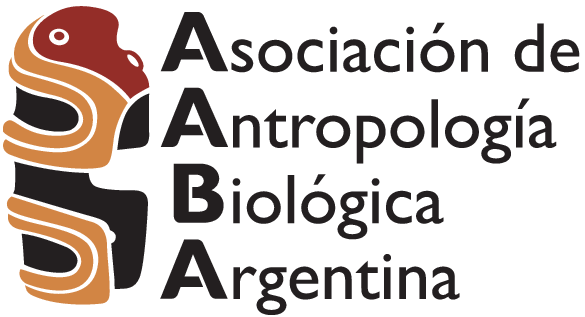Crecimiento y desarrollo de una población infanto juvenil de la provincia de Chubut
Resumen
RESUMEN: La diferenciación y adaptación ontogenética son temas centrales en antropología biológica por cuanto su modificación puede afectar la dinámica evolutiva poblacional. Numerosos factores estresantes actúan provocando variación en la expresión fenotípica y nuevas respuestas adaptativas. En el presente trabajo se determinó el crecimiento de niños de 5 a 14 años contrastando con estándares internacionales. La muestra se constituyó con 473 escolares de Río Mayo (Chubut), de ambos sexos. Se relevaron y calcularon variables corporales. Para la comparación con los estándares los datos fueron convertidos a escores z y contrastados además mediante pruebas de Wilcoxon. La estadística empleada consistió en análisis multifactorial de la varianza y pruebas de LSD. Si bien hubo crecimiento en todos los grupos etáreos analizados, los valores obtenidos difirieron significativamente de los correspondientes al estándar. En varones, a excepción del pliegue subescapular, que presentó escores z superiores al estándar las restantes variables se ubicaron entre 0 y -2 DS, siendo más afectadas las estaturas total y sentado y el área muscular. En mujeres, se observó una situación similar a excepción del área adiposa y la masa corporal, con valores mayores al estándar. Estos resultados evidencian la presencia de una desnutrición que abarca toda la franja etárea. La disminución de la talla y el aumento del tejido adiposo constituyen sin duda, respuestas adaptativas que permiten la supervivencia de los individuos frente a la injuria nutricional. Rev. Arg. Antrop. Biol. 2(1): 107-122, 1999.
ABSTRACT: The processes of ontogenetic adaptation and differentiation are main subjects in Biological Anthropology, since they can affect the dynamics of a population. Many environmental factors act evoking variation in the phenotypic expression of people, and affecting their adaptive responses. In the present study, growth in 473 schoolchildren from 5 to 14 years old belonging to Río Mayo (Province of Chubut, Argentina) was tested against internacional standards; data being, previously transformed into z-scores. Statistical comparisons included the non-parametric Wilcoxon test, the analysis of variance and multiple range post-hoc tests. Although growth was evident in all of the analyzed age groups, the obtained values differed significantly from the those of the standards. In males, with the exception of the subscapular skinfold which showed z-scores higher than the standards, the variables ranged between 0 and -2 SD; being the standing, and sitting heights, and the muscle area mostly affected. Similar results were seen in females, except that the adipose area and the body mass index showed higher values than those of the standards. These results showed that undenutrition was present in all of the studied age stages. The decreasing standing height and the increasing fat tissue found are adaptive responsos of growing people to survive in such a nutritionally stressed environment. Rev. Arg. Antrop. Biol. 2(1): 107-122, 1999.
Descargas
Referencias
Beck B, Dollct JM, Max JP y Debry G (1983) Relations among weight deficit, food intake and early deprivation in long-term protein malnourished rats. Nutr. Res. 3:743-748.
Bogin B y Sullivan T (1986) Socioeconomic status, sex, age, and ethnicity as determinants of body fat distribution for guatemalan children. Am. J. Phys. Anthropol. 69:527-535
Bogin B y Loucky J (1997) Plasticity, political economy, and physical growth status of Guatemala Maya children living in the United States. Am. J .Phys. Anthropol. 102:17-32.
Boldsen JL ( 1995) The place of plasticity in the study of secular trend for male stature: an analysis of danish biological population history. En Mascie-Taylor CGN y Bogin B (eds.): Human Variability and Plasticity. Cambridge, Cambridge University Press.
Bolzán AG, Guimarcy LM y Pucciarelli HM (1993) Crecimiento y dimorfismo sexual en escolares según la ocupación laboral paterna. Arch. Latinoamer. Nutr. 43:132-138.
Cameron N, Gordon-Larsen P y Wrchota EM (1994) Longitudinal analysis of adolescent growth in height, fatness and fat patterning in rural south african black children. Am. J. Phys. Anthropol. 93:307-321.
Deutsch MI, Mueller WH y Malina RM (1985) Androgyny in fat patterning is associated with obesity in adolescents and young adults. Ann. Hum. Biol. 12:275-286.
Eveleth PB y Tanner JM (1990) Worldwide Variation in Human Growth. 2° ed. Cambridge, Cambridge University Press.
Frisancho AR (1981) New norms of upper limb fat and muscle areas for the assessment of nutritional status. Am.J.Clin.Nutr. 34:2540-2545.
Frisancho AR (1990) Anthropometric Standards for the Assessment of Growth and Nutritional Status. Ann Arbor, The University of Michigan Press.
Gargallo Fernández MA, de la Cruz Iglesias AI, Garrudo Benito D y de Cos Blanco AI (1993) Estatus antropométrico - nutricional de una población juvenil de clase media española. Estudio por grupos de edad y sexo. Nutr. Hosp. 8:301-305.
Goodman A, Brooke Thomas R, Swedlund A y Armelagos G (1988) Biocultural perspectives on stress in prehistoric, historical and contemporary population research. Yrbk. Phys. Anthropol. 31:169-202.
Guimarey L, CarnescFR, Pinotti L, Pucciarelli HM y Goicoechea AS (1993) Crecimiento en escolares de Villa IAPI (Quilines, Bs.As., Argentina) Arch. Latinoamer. Nutr. 43:139-145.
Guimarey L, Carnese FR y Pucciarelli HM (1995) La influencia ambiental en el crecimiento humano. Ciencia Hoy 5:41 -47.
Hermanussen M (1997) Plasticity of adolescent growth in boys. Am. J. Hum. Biol. 9:469-480.
Kriscautzky DBL de ( 1985) Evaluación nutricional en niños que concurren a comedores escolares en la provincia de Catamarca. Arch. Arg. Pediatr. 83:43-5 1.
Lieberman L ( 1982) Normal and abnormal sexual dimorphic patterns of growth and development. En Hall R (ed): Sexual Dimorphism in Homo sapiens. New York, Praeger, pp.253-3 16.
Little MA (1995) Adaptation, adaptability, and multidisciplinary research. En Boaz NT y Wolfe LD (eds.): Biological Anthropology. The State of the Science. Oregon, International Institute for Human Evolutionary Research, pp. 121-147.
Malina RM (1975) Anthropometric correlates of strength and motor performance. Excercise Sport Sci. Rev. 3:249-274.
Martorell R, Yarbrough C, Lechtig A, Delgado H y Klein RE (1976) Upper arm anthropometric indicators of nutritional status. Am. J. Clin. Nutr. 29:46-53.
Martorell R, Mendoza F y Castillo R (1987) Pobreza y estatura en la infancia. XIV Seminario de Nestlé Nutrition. Thailandia, pp. 17-20.
Mueller WH (1982) The changes with age of the anatomical distribution of fat. Soc. Sci. Med. 16:191-196.
Orden BA (1997) Ontogenia del dimorfismo craneano sexual y su alteración por factores nutricionalcs. Un estudio de antropología biológica experimental. Tesis Doctoral. Facultad de Ciencias Naturales y Musco. Universidad Nacional de La Plata.
Oyhenart EE, Torres MF, Dahinten SL, Pucciarelli HM y Carnese FR (1998) Dimorfismo sexual en tehuelches de El Chalía (Chubut). Trabajo no publicado.
Oyhenart EE, Muñe MC y Pucciarelli HM (1998) Influence of intrauterine blood supply on cranial growth and sexual dimorphism at birth. Growth, Develop & Aging 62:187-198.
Pucciarelli HM, Carnese FR, Pinotti LV, Guimarey LM y Goicoechca AS (1993) Sexual dimorphism in schoolchildren of the Villa IAPI neighborhood (Quilmes, Buenos Aires, Argentina). Am. J. Phys. Anthropol. 92:165-172.
Pucciarelli HM, Carnese FR y Guimarey LM (1996) Desnutrición y dimorfismo sexual. Ciencia Hoy 6:53-59.
Ramírez ME y Mueller WH (1980) The development of obesity and fat patterning in Tokeleau children. Hum. Biol. 52:675-688.
Rolland-Cachcra MF, Bellisne F y Fricker J (1996) Obésité. En Traité dc Nutrition Pédiatrique. París, Maloinc, pp. 690-723.
Tanner J (1962) Growth at Adolescence. Oxford, Oxford Blackwell.
Tanner I (1986) El hombre antes del Hombre. El Crecimiento Físico desde la Concepción hasta la Madurez. México, Fondo de Cultura Económica.
Torres MF, Oyhenart EE, Dahinten SL, Carnese FR y Pucciarelli HM (1998) Crecimiento en una población tehuelche de Chubut (Argentina). Trabajo no publicado.
Ulijaszcck SJ (1995) Growth and body size. En Human Energetics in Biological Anthropology. Cambridge, Cambridge University Press, pp. 128-150.
Waddington CH (1957) The Strategy of the Genes. London, Allen and Unwin Ltd.
Watanabe T, Yamamoto Y, Miyashita M y Mutoh Y (1998) Secular change in running performance of japanesc adolescent: A longitudinal developmental study. Am. J. Hum. Biol. 10:765-779.
Widdowson EM y McCance RA (1960) Some effects of accelerating growth. I. General somatic development. Proc. R. Soc. 152:188-206.
Winick M y Rosso P (1969) The effect of severe early malnutrition on cellular growth of human growth brain. Pediatr. Res. 3:181-184.
Descargas
Publicado
Número
Sección
Licencia
La RAAB es una revista de acceso abierto tipo diamante. No se aplican cargos para la lectura, el envío de los trabajos ni tampoco para su procesamiento. Asímismo, los autores mantienen el copyright sobre sus trabajos así como también los derechos de publicación sin restricciones.






























